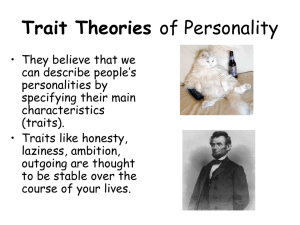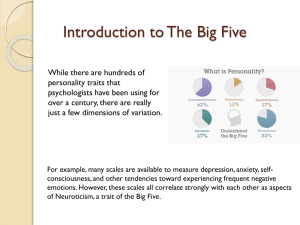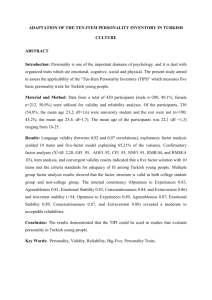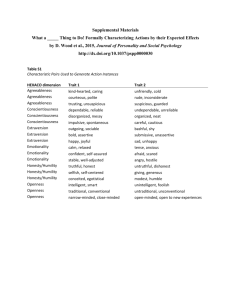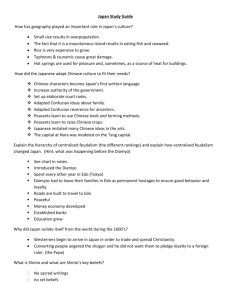Confucianism, Personality Traits, and Effective Leaders Yoshimi Ishibashi and Janet Kottke
advertisement
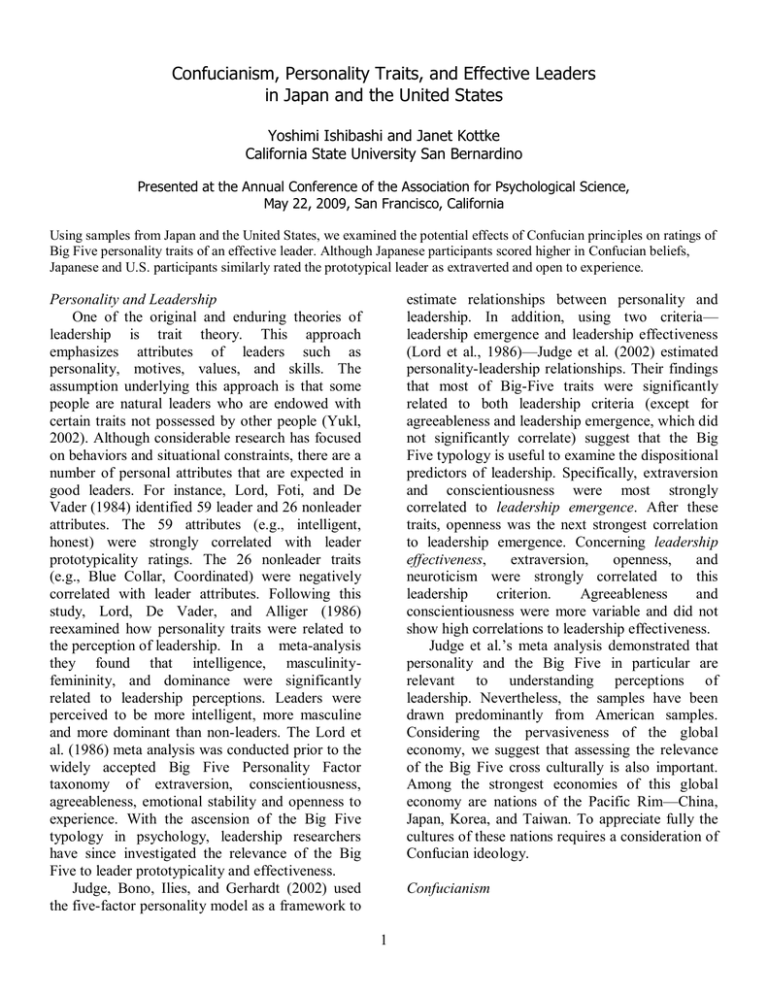
Confucianism, Personality Traits, and Effective Leaders in Japan and the United States Yoshimi Ishibashi and Janet Kottke California State University San Bernardino Presented at the Annual Conference of the Association for Psychological Science, May 22, 2009, San Francisco, California Using samples from Japan and the United States, we examined the potential effects of Confucian principles on ratings of Big Five personality traits of an effective leader. Although Japanese participants scored higher in Confucian beliefs, Japanese and U.S. participants similarly rated the prototypical leader as extraverted and open to experience. Personality and Leadership One of the original and enduring theories of leadership is trait theory. This approach emphasizes attributes of leaders such as personality, motives, values, and skills. The assumption underlying this approach is that some people are natural leaders who are endowed with certain traits not possessed by other people (Yukl, 2002). Although considerable research has focused on behaviors and situational constraints, there are a number of personal attributes that are expected in good leaders. For instance, Lord, Foti, and De Vader (1984) identified 59 leader and 26 nonleader attributes. The 59 attributes (e.g., intelligent, honest) were strongly correlated with leader prototypicality ratings. The 26 nonleader traits (e.g., Blue Collar, Coordinated) were negatively correlated with leader attributes. Following this study, Lord, De Vader, and Alliger (1986) reexamined how personality traits were related to the perception of leadership. In a meta-analysis they found that intelligence, masculinityfemininity, and dominance were significantly related to leadership perceptions. Leaders were perceived to be more intelligent, more masculine and more dominant than non-leaders. The Lord et al. (1986) meta analysis was conducted prior to the widely accepted Big Five Personality Factor taxonomy of extraversion, conscientiousness, agreeableness, emotional stability and openness to experience. With the ascension of the Big Five typology in psychology, leadership researchers have since investigated the relevance of the Big Five to leader prototypicality and effectiveness. Judge, Bono, Ilies, and Gerhardt (2002) used the five-factor personality model as a framework to estimate relationships between personality and leadership. In addition, using two criteria— leadership emergence and leadership effectiveness (Lord et al., 1986)—Judge et al. (2002) estimated personality-leadership relationships. Their findings that most of Big-Five traits were significantly related to both leadership criteria (except for agreeableness and leadership emergence, which did not significantly correlate) suggest that the Big Five typology is useful to examine the dispositional predictors of leadership. Specifically, extraversion and conscientiousness were most strongly correlated to leadership emergence. After these traits, openness was the next strongest correlation to leadership emergence. Concerning leadership effectiveness, extraversion, openness, and neuroticism were strongly correlated to this leadership criterion. Agreeableness and conscientiousness were more variable and did not show high correlations to leadership effectiveness. Judge et al.’s meta analysis demonstrated that personality and the Big Five in particular are relevant to understanding perceptions of leadership. Nevertheless, the samples have been drawn predominantly from American samples. Considering the pervasiveness of the global economy, we suggest that assessing the relevance of the Big Five cross culturally is also important. Among the strongest economies of this global economy are nations of the Pacific Rim—China, Japan, Korea, and Taiwan. To appreciate fully the cultures of these nations requires a consideration of Confucian ideology. Confucianism 1 Confucian ideology has shaped and continues to shape social roles in Asian cultures. Confucius was a Chinese philosopher and teacher 2,500 years ago during a period of great social turmoil. His fundamental ideals were “to establish stable, reciprocal, ethical, but fundamentally nonegalitarian social relationships based on gender, age, and position in society” (Chinn, 2002, p. 304). Confucian ethics defined relationships between ruler and the governed, father and son, husband and wife, elder and younger brother, even those between friends with the goal of establishing a stable society. Confucianism’s nonegalitarian ideology continues to have a strong influence on social roles not only in China’s educational, bureaucratic, and legal systems but also in Japan and Korea (Chinn, 2002). Confucian relationships still have a strong impact on the family structure and governmental policies even though these nations have attempted to modernize their societies and legal systems. Leung and Bozionelos (2004) examined the Confucian principles in conjunction with the fivefactor model (FFM) of personality, using a Hong Kong sample. They examined which traits of the FFM were influenced by the Confucian principles and were seen as important to characterizing the effective leader. They wanted to examine whether there were traits or personalities unique to the Confucian culture. As previously noted, FFM personality consists of neuroticism, extraversion, openness, agreeableness and conscientiousness. Reflecting characteristics of the Confucian culture such as “industriousness, sacrifice of personal interests over group interest, concealment of emotions, and low profile” (p.64), Leung and Bozionelos expected that extraversion and openness would be negatively related to the prototypical notion of the effective leader in a Confucian culture. Extraversion is associated with ambition and high profile, and openness is associated with low conservatism. Therefore, they hypothesized that the characteristics of conscientiousness, agreeableness, and emotional stability (low neuroticism) would positively be associated with the prototypical notion of the effective leader in Hong Kong. Their results revealed that the characteristics of conscientiousness, agreeableness, and emotional stability (low neuroticism) were positively associated with the prototypical notion of the effective leader, as predicted. Openness was not strongly related to the prototype of the effective leader in Confucian culture. Contrary to their expectations, extraversion was the most strongly associated of the Big Five personality traits identified with the prototypical notion of the effective leader. The primary limitation of their study was the sample was from Hong Kong, which has experienced a long-term British influence. Therefore, the sample might not have been entirely representative of individuals fully influenced by Confucian values. How might Confucian principles affect expectations of the leadership role in Japan? Whitehill (1992) noted that the Confucian doctrines of unquestioned obedience to the family, loyalty to one’s superior and reverence for education are evidenced in the disciplines of Japanese management practices. Islam (1997) also suggested that the relationships inherent in Confucian principles have transferred to Japanese companies, such as “a paternalistic management style, loyalty to company, distinction between juniors and seniors, work based on group and differential treatment between male and female” (p. 152). Therefore, we predicted that within a Japanese sample, an effective leader would be expected to be conscientious, agreeable, and emotionally stable, but introverted and not open to experience—the same predictions made by Leung and Bozionelos (2004). Hypotheses Before we addressed the predictions regarding the Big Five personality factors, we first assessed the cultural differences between the U.S. and Japan based on Confucian ideology. Specifically, we hypothesized that: H1. Japanese participants will score higher on Confucian values than U.S. participants. Then, to address the expected differences between ratings of prototypical leaders, we hypothesized: H2. Extraversion and openness will be the lowest rated traits for the prototypical leader in the Japanese sample. Conscientiousness, 2 agreeableness and emotional stability will be the highest rated traits for an effective leader in the Japanese sample. Surveys were distributed by faculty at Toyo University (Tokyo), Senshu University (Kanagawa prefecture, adjacent to Tokyo), and Wakayama University (southwestern Japan). The number of surveys collected at each of these universities was 31 at Toyo, 35 at Senshu, and 79 from Wakayama. Participants were randomly assigned to the experimental conditions. Their participation was voluntary and participants were treated in accordance with the APA Standards. Because no study was found that asked U.S. participants to rate the Big Five personality factors of their leaders, we had no research comparable to Leung and Bozionelos (2004) upon which to base our hypotheses for the U.S. participants. As noted previously, there has been research examining how the Big Five are revealed in leadership behaviors. For example, Judge, Bono, Ilies, and Gerhardt (2002) found using meta-analysis that extraversion, conscientiousness and openness had the strongest and most consistent correlations with leadership success. Specifically, extraversion was the most important trait of effective leaders. To the degree that participants who observe leaders accurately detect those personality characteristics, all fivepersonality dimensions are positively associated with the prototypical leader in the U.S. Therefore, we predicted: Demographic Information We asked participants their age, gender, employment status (full time, part time, or not currently employed), student status (1st year, 2nd year, 3rd year, 4th year, or other), and major. We also asked participants of the American sample if they were international students to clarify their status as American students. Additionally, there was a question of their primary language to confirm the cultural background of the American sample. Only students for which English was their first language were included in the American sample. To include participants who were businessoriented, all participants were asked about their plans after graduation. Therefore, not all their majors were business-related (e.g. psychology, literature), but participants whose plans were business-oriented (e.g. working in an organization upon graduation) were included. H3. Japanese participants will rate the extraversion and openness of prototypical leaders lower than will U.S. participants. H4. No differences by sample will be found in the ratings of conscientiousness, agreeableness, or emotional stability. Method Materials The U.S. participants were administered an English version of the survey and the Japanese participants answered a version in the Japanese language. The materials for the Japanese sample were translated from English into Japanese by the first author (a native speaker of Japanese) and back translated by another native speaker of Japanese who was also fluent in English (a faculty member at CSUSB). Unfortunately, after administration had begun, an error was detected in the Japanese version survey. One row of the Big Five personality survey was missing. This omission affected two items of extraversion, and one item of both conscientiousness and emotional stability. Item means were used in subsequent analyses as long as there were six valid item responses available. Participants Participants were undergraduate students in the United States and Japan whose major was business-related or who planned to work (in an organization) after graduation. After removing surveys that were incomplete, evidenced haphazard responding, or for which the respondents were ineligible (i.e., were not business majors or were not planning to work after graduation), there were 148 usable American surveys (56 male and 92 female) and 141 usable Japanese surveys (85 male and 56 female). Procedure For the U.S. sample, we collected surveys at California State University, San Bernardino. 3 scale (CVS-II), all comparisons in three countries were significant: The PRC sample reported the highest mean score, followed by the Hong Kong and then the U.S. Because the focus of our research was about the work situation, we returned two items from the original study to the work dynamism subscale. Although “Industry (working hard)” and “Loyalty to superior” did not load significantly on the original scale (Chinese Culture Connection, 1987), the two items would seem to be consistent with the work dynamism construct. Therefore, we included the 10 items for the Confucian work Dynamism scale. Specifically, participants were asked to rate the importance of each item for themselves. They answered by using a 9-point scale ranging from 1 (of no importance to me at all) to 9 (of supreme importance to me). Measures Big Five Mini-marker. The second set of hypotheses investigated personality traits associated with the prototypical image of the effective leader by using the Mini-Marker survey of the Big Five personality traits (Saucier, 1994). Saucier (1994) developed the Mini-Marker subset based on Goldberg’s (1992) Big Five factor structure. The Mini-Marker subset contains 40 adjectives. The adaptation for this study was that participants were asked, “How much should an effective leader possess the following characteristics?” They answered by using a 9-point scale ranging from 1 (extremely: should not possess) to 9 (extremely: should possess). Chinese Value Survey. To verify any cultural differences that can be attributed to the differences in Confucian culture, we included the Chinese Value Survey. In 1978, the Chinese Culture Connection, an international network of colleagues, developed an instrument to measure Eastern value systems. They created the Chinese Value Survey (CVS) and administered it to university students in 22 countries around the world. The CVS consisted of 40 items whose degree of perceived importance was rated on a 9-point scale. The items chosen were considered fundamental to Chinese culture by a group of Chinese scholars and include basic components of the Chinese traditions such as moderation, ordering relationships by status, benevolent authority, being conservative, and having a sense of shame. Four factors emerged from the factor analysis: Integration (CVS-I), Confucian Work Dynamism (CVS-II), HumanHeartedness (CVS-III), and Moral Discipline (CVS-IV). Regarding factor scores of the U.S. and Japan, Japanese scores were higher than the U.S. scores on all factors. The researchers of the Chinese Culture Connection argued that the eight items of CVS-II could be considered unique to Eastern culture and heavily Confucian. In addition, Ralston, Gustafson, Elsass, Cheung, and Terpstra (1992) conducted a survey to extend the previous study (The Chinese Culture Connection, 1987) and to examine the differences and similarities in values among managers in the United States, Hong Kong, and the People’s Republic of China (PRC), using the CVS dimensions. On the Confucian Work Dynamism Results Data Screening Prior to beginning data analysis, the assumptions of normality were evaluated through SPSS. There were no variables with 5 percent or more missing values, and there were no significant patterns of missing data using a criterion of p < .001. Using a criterion of z = |3.3|, p < .001, twelve cases with extremely low z scores on one or more variables were found to be univariate outliers. Therefore, these cases were deleted. After detecting univariate outliers, we checked for multivariate outliers. There were no significant multivariate outliers. After deleting all outliers and the evaluation of the assumptions, 277 cases were left for analysis. There were 136 cases in the Japanese sample and 141 cases in the U.S. sample. Comparing Samples on Confucian Values To evaluate the first hypothesis that the Japanese students would score more highly on Confucian values, a t-test was used to compare scores of the U.S. and Japanese samples. The t test revealed that the mean scores of the U.S. sample and the Japanese counterparts were significantly different in Confucian values, t(264) = 2.30 p < .05. As predicted, the mean scores of the Japanese sample (M = 6.74) were higher than their U.S. counterparts (M = 6.49). The expectation that there 4 would be cultural differences between the two countries regarding Confucian values was found. Before analyzing the Big Five personality data, we investigated whether the Japanese participants would report more acceptance of Confucian values. If the Japanese students achieved higher scores on Confucian values than the U.S. sample, this cultural difference would help to support the contention that cultural values may explain, in part, the results of potential differences in ratings of the Big Five personality. As we predicted, the scores on the measure of Confucian ideals was higher in the Japanese sample than in the U.S. sample. Therefore, despite apparent changes to Japanese society (Hendry, 2003), the Japanese students are likely still being influenced by Confucian values. Reflecting Confucian values, extraversion and openness were expected to be rated lower as traits of an effective leader in Japan, compared to the other three traits of Big Five personality. Therefore, we predicted that the Japanese participants would report that an effective leader should not possess extraversion and openness to any great extent. In addition, we predicted that they would report that an effective leader was more likely to possess agreeableness, conscientiousness, and emotional stability. However, the Japanese participants did not differentiate the first two traits (extraversion and openness) from the second three traits (agreeableness, conscientiousness, and emotional stability) as expected. A review of the graph in Figure 1 indicates that the lowest means were not extraversion or openness but agreeableness and emotional stability. The result that agreeableness and emotional stability were the lowest ratings was in the opposite direction of the results of Leung and Bozionelos’ study (2004). Despite the greater Confucian values found in the Japanese sample, there was no effect of Confucian culture apparent in the Big Five profiles1. We note there, however, that although the impact of Confucian values was not found among Japanese students, the mean for conscientiousness was in the direction of the Leung and Bozionelos (2004) study. We had predicted the U.S. students would rate extraversion and openness higher than the Japanese students would. The results revealed that the U.S. participants did rate extraversion higher. There was not a difference by sample in the rating of openness in reference to an effective leader. We had predicted differences between the two countries in the ratings of agreeableness, Big Five Personality Traits Using a within-subjects contrast, we compared extraversion and openness with conscientiousness, agreeableness, and emotional stability for the Japanese sample. The results showed that these contrasts were not significantly different, F(1, 127) = .23, p = .635. Contrary to the prediction, Japanese students did not rate extraversion and openness lower than conscientiousness, agreeableness, and emotional stability as effective leaders’ traits. In the second hypothesis we compared by sample the ratings of the traits, extraversion and openness, with the expectation that the U.S. students would rate these higher than the Japanese students. To examine this hypothesis, we used pairwise comparisons. The ratings of extraversion were significantly different in the U.S. and Japanese samples [F(1, 262) = 5.23, p < .05] but the ratings for openness were not [F(1, 262) = 2.80, p = .096]. For the third hypothesis, we focused on comparing ratings of conscientiousness, agreeableness, and emotional stability by sample. Using pairwise comparisons, the ratings of agreeableness, conscientiousness, and emotional stability were different in the U.S. and Japanese sample. Specifically, the ratings of the U.S. sample were higher than their Japanese counterparts (see Table 1 and Figure 1). That is, the U.S. students were more likely to consider that an effective leader should possess these traits, compared to the Japanese students, agreeableness, [F(1, 262) = 29.76, p < .05, partial η2 = .10], conscientiousness, [F(1, 262) = 27.07, p < .05, partial η2 = .09], and emotional stability, [F(1, 262) = 54.52, p < .05, partial η2 = .17]. Discussion We analyzed cultural variations of perspectives of an effective leader. In particular, we examined whether Confucian culture influenced the ratings of Big Five personality as applied to the prototype of an effective leader. Big Five Personality and Confucian Values 5 conscientiousness, and emotional stability. We had hypothesized that agreeableness, conscientiousness, and emotional stability would be seen as more important for an effective leader in Japan. Therefore, we had expected the Japanese scores would be higher on these traits, compared to the U.S. scores. However, although variation was found on agreeableness, conscientiousness, and emotional stability, it was the U.S. students who rated these traits higher for a leader than the Japanese students. Overall, we found little evidence that the Big Five personality of the prototypical leader was influenced by Confucian values, as was shown by Leung and Bozionelos (2004). One of the possible reasons for this result was that the questionnaire asked about “an effective leader.” If we had asked students to rate themselves (e.g., self-description ratings) on their potential for leadership, the influence of Confucian values may have been evident in the ratings of the Big Five personality. Also, the lowest factor, emotional stability, has six negatively worded items out of eight items. Therefore, when Japanese students answered these items, the negatively worded items might have been less clear to them than the positively worded items. There is some evidence that scales with mixed items (both positively and negatively worded statements) may not yield comparable measurements when used cross culturally (Wong, Rindfleisch, & Burroughs, 2003). Further, the differences that did emerge have to be tempered with the fact that the ratings across all factors were relatively high. When we inspect the Big Five subscale means, we see that the average ratings (predominantly in the 7s) were well beyond the midpoint of the scale (5). On a nine point scale, the lowest mean was emotional stability at 6.35 (Japanese sample). We might interpret from the size of the means that all Big Five personality factors were rated as somewhat important, regardless of sample, for effective leadership. we asked a third party (professors at each University) to collect the data. Therefore, if students had questions, no one knowledgeable about the survey could answer them. Considering this situation, perhaps students responded to questions despite potential difficulties in understanding the task. Because the original survey materials were in English, the translated surveys in Japan may not have conveyed the meaning intended. Although the translations and back translations were done by native Japanese speakers who also understood English, it is possible that the construct meanings were not equivalent. Conclusion Concerning the impact of cultural differences, Japanese students did not show the influence of Confucian values on Big Five personality in rating an effective leader. They perceived an effective leader should possess traits that are similar to those valued in Anglo-Saxon society. References Chinese Culture Connection. (1987). Chinese values and the search for culture-free dimensions of culture. Journal of Cross-Cultural Psychology, 18(2), 143-164. Chinn, P. W. (2002). Asian and Pacific Islander women scientists and engineers: A narrative exploration of model minority, gender, and racial stereotypes. Journal of Research in Science Teaching, 39(4), 302-323. Goldberg, L. R. (1992). The development of markers for the Big-Five factor structure. Psychological Assessment, 4, 26-42. Hendry, J. (2003). Understanding Japanese society. New York: Routledge. Islam, M. M. (1997). Attitude and consciousness of Japanese men and women towards career commitment and continuity: the role of expected change in HRM policies. The International Journal of Human Resource Management, 8(2), 150-171. Judge, T. A., Bono, J. E., Ilies, R., & Gerhardt, M. W. (2002). Personality and leadership: A qualitative and quantitative review. Journal of Applied Psychology, 87(4), 765-780. Leung, S. L., & Bozionelos, N. (2004). Five-factor model traits and the prototypical image of the effective leader in the Confucian culture. Employee Relations, 26(1), 62-71. Limitations There are limitations that must be considered in interpreting our results. First, data regarding the Confucian scale were collected through self-ratings. It is always possible that when participants rate themselves, they intentionally (or unintentionally) bias their ratings. Further, for the Japanese surveys, 6 Lord, R. G., De Vader, C. L., & Alliger, G. M. (1986). A meta-analysis of the relation between personality traits and leadership perceptions: An application of validity generalization procedures. Journal of Applied Psychology, 71(3), 402-410. Lord, R. G., Foti, R. J., & De Vader, C. L. (1984). A test of leadership categorization theory: Internal structure, information processing, and leadership perceptions. Organizational Behavior and Human Performance, 34, 343-378. Ono, H. (2003). Women’s economic standing, marriage timing, and cross-national contexts of gender. Journal of Marriage and Family, 65, 275-286. Ralston, D. A., Gustafson, D. J., Elsass, P. M., Cheung, F., & Terpstra, R. H. (1992). Eastern values: A comparison of managers in the United States, Hong Kong, and the People’s Republic of China. Journal of Applied Psychology, 77(5), 664-671. Saucier, G. (1994). Mini-Markers: A brief version of Goldberg’s unipolar big-five markers, Journal of Personality Assessment, 63(3), 506-516. Whitehill, A. M. (1992). Japanese managementTradition and transition. London and New York: Routledge. Wong, N., Rindfleisch, A., & Burroughs, J. E. (2003). Do reverse-worded items confound measures in cross-cultural consumer research? Journal of Consumer Research, 30(1), 72-91. Yukl, G. (2002). Leadership in organization. (5th ed.). New Jersey: Prentice Hall. Author Notes This study was conducted by the first author as part of her thesis research, under the supervision of the second author. Please address correspondence to the second author at jkottke@csusb.edu. Footnote In addition, as Leung and Bozionelos found an effect for gender, we examined a profile analysis by gender in Japan. Contrary to the previous study, Japanese male and female students did not rate Big Five personality traits differently. 1 Table 1. Means of the Big Five personality variables by sample, U.S. and Japanese Variable Extraversion Agreeableness Conscientiousness Emotional Stability Sample Japanese 6.98a 6.78 a 7.83 a 6.35 a b b b American 7.19 7.43 8.20 7.25 b Note. Different superscripts indicate significantly different means. Figure 1. Profile of the Big Five personality variables by sample, U.S. and Japanese 8.40 8 7.60 Japanese 7.20 American 6.80 6.40 6 Extra Agree Consci EmStab Open 7 Openness to Experience 7.05 6.90

